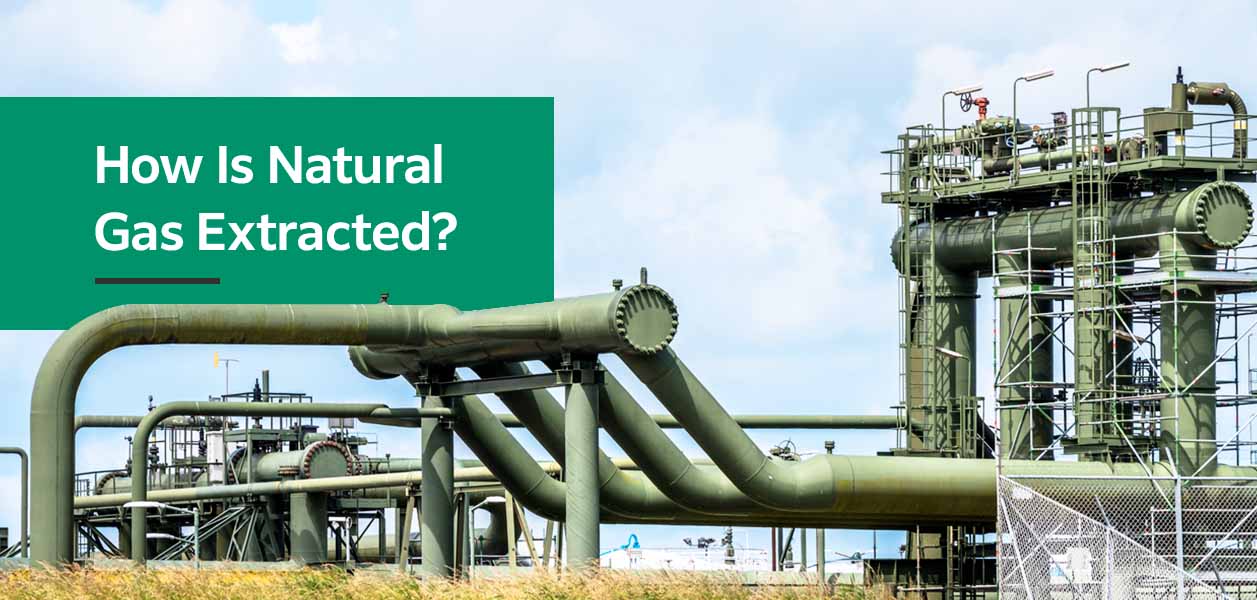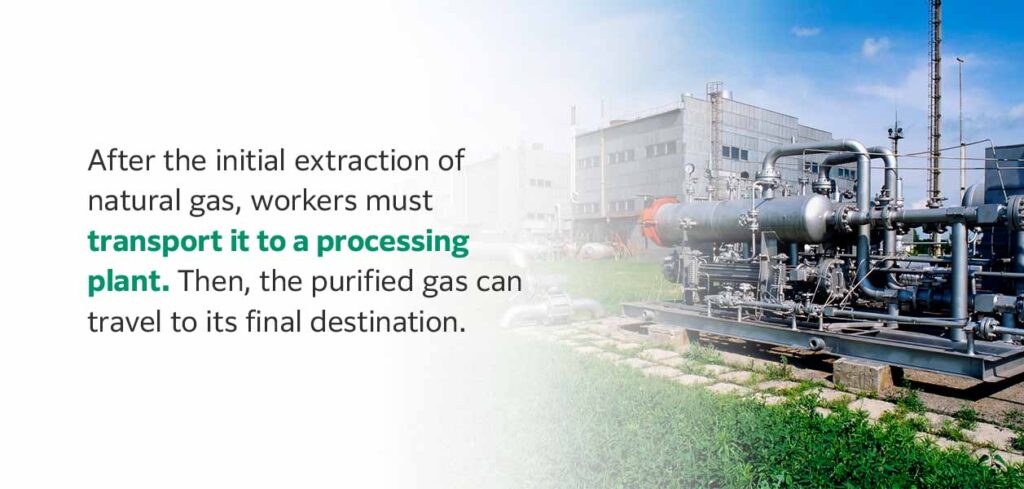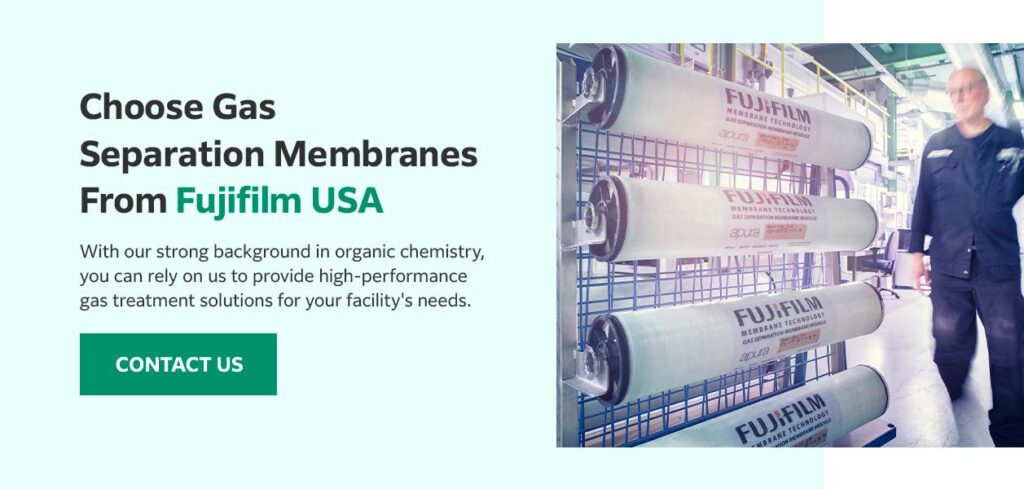
Jump to:
- What is Natural Gas?
- How is Natural Gas Located?
- Natural Gas Extraction Methods
- What Occurs After Natural Gas Extraction?
Natural gas is one of the cleanest-burning fossil fuel sources, releasing significantly less carbon dioxide into the atmosphere than coal and distillate fuel oil.
Due to environmental concerns, extracting and using natural gas is a sensitive matter. However, with new technologies and extraction techniques under development, the future seems promising for this methane-based fuel.
What Is Natural Gas?
Natural gas is a fossil fuel like coal or oil. Like other fossil fuels, natural gas forms through the underground decomposition of dead plants and animals. Unlike other fossil fuels, it is almost entirely methane, the most abundant organic compound on the planet.
Where Does Natural Gas Come From?
While there are several theories about how natural gas forms, the most commonly accepted hypothesis states that it forms underground under intense heat and pressure. Here is how that process breaks down.
- Decomposition: Dead plants and animals decompose under growing layers of earth and rock.
- Descent: As layers compound on each other, they push the organic matter deeper, closer to the crust. The temperature increases as it gets deeper.
- Compression: The increasing pressure and rising temperatures compress the organic matter, causing the carbon bonds to break down. This breakdown produces thermogenic methane, the scientific term for natural gas.
Another way natural gas forms is through methanogenesis, which is a form of anaerobic cellular respiration. Essentially, it is a process that breaks down carbon compounds into biogenic methane in a low- or zero-oxygen environment.
Though our existing technology limits us to using thermogenic methane for fuel, scientists are developing solutions for extracting and using biogenic methane.
How Do We Locate Natural Gas?
While some of the thermogenic methane escapes into the atmosphere through porous rock, most of it remains trapped below the surface.
To determine where to begin harvesting natural gas, geologists conduct seismic surveys, which involve creating and measuring tectonic activity to map out nearby rock formations. If a site seems promising, the team will drill an exploratory well to test how much natural gas they can expect to find. Then, production begins.
Where Is Natural Gas Found?
Natural gas deposits often occur near oil deposits. Their composition depends on how close they are to the surface.
- Surface-level: The highest deposits typically contain more oil than natural gas.
- Mid-level: The deeper the deposit is, the more natural gas it will contain, due to the higher temperatures and pressures that occur at deeper levels.
- Deep: The deepest deposits are likely to consist of pure natural gas. However, it may still contain contaminants like water, carbon dioxide or natural gas liquids.
Sedimentary basins exist worldwide, from Saudi Arabia to Alaska. Prominent U.S. locations include the Gulf states, Texas, Louisiana, North and South Dakota and Montana.
Natural Gas Extraction Methods
Most companies use vertical drilling for natural gas as their primary extraction technique. While this method is reliable, it limits the yield to only what is available in the sedimentary basin. The company must set up additional drilling sites to harvest more.
Other ways to extract natural gas include the following.
- Horizontal drilling: Once the drill is under the surface, operators can redirect it horizontally. This technique increases the potential yield without requiring more drilling sites, which keeps costs low and minimizes environmental damage.
- Hydraulic fracturing: Also known as fracking or unconventional production, hydraulic fracturing uses high-pressure water, chemical and sand streams to split rock formations and release trapped natural gas. However, fracking has numerous environmental concerns, such as habitat damage and micro-earthquakes.
- Acidizing: By dissolving acidic compounds and injecting them into the natural gas deposit, harvesters can dissolve rock and release natural gas flow.

What Occurs After Natural Gas Extraction?
After the initial extraction of natural gas, several other processes must happen before it is ready to use. First, workers must transport it to a processing plant. Then, the purified gas can travel to its final destination.
Transportation
Most of the time, natural gas travels through underground pipelines ranging from 2 to 60 inches in diameter. The continental U.S. has a vast network of pipelines totaling approximately 305,000 miles.
Another method of transporting natural gas is by creating liquefied natural gas, which is easy to store and move without pipelines. Making LNG involves cooling natural gas down to -260 degrees Fahrenheit, then transferring it into insulated tankers for transport. These tankers keep the LNG at its boiling point, and if any of the gas vaporizes, it can power the vehicle.
However, in oil harvesting operations where natural gas pipelines are unavailable, the drilling company will either:
- Reinject the gas into the oil well
- Vent or burn the gas in a process called flaring
The raw gas then travels to the processing plant, where it undergoes various treatments to remove unwanted impurities.
Processing
Before we can use natural gas, we need to treat it to remove contaminants like water, hydrogen sulfide and carbon dioxide. This step ensures a clean, safe burn.
Processing plants use different gas separation techniques like these.
- Gas separation membrane: Gas separation is a simple, cost-effective processing method. The process works by feeding pressurized natural gas through the selectively permeable gas separation membrane, which filters out contaminants without forming any hydrates.
- Mechanical refrigeration: This highly flexible technique uses a refrigeration chiller system to separate hydrocarbons through selective condensation.
- Amine treatment: “Sweetening” raw natural gas with an amine solution removes acidic contaminants like carbon dioxide and hydrogen sulfide through absorption and separation.
Some techniques, such as amine gas treatment, use high amounts of energy and resources. Others, like gas separation, are highly energy-efficient and incorporate easily into most applications. The best method for each company depends heavily on the plant’s budget and facility.
Consumption
According to the U.S. Energy Information Administration, natural gas accounted for 32% of total national energy consumption in 2021. Examples of applications for natural gas include the following.
- Residential: Typical uses for natural gas in homes are cooking and heating. It also powers home appliances like space heaters, outdoor lights and clothes dryers.
- Transportation: Though they cost more upfront than gas-powered vehicles, natural gas vehicles are more cost-effective and environmentally friendly.
Choose Gas Separation Membranes From Fujifilm USA
With our strong background in organic chemistry, you can rely on us to provide high-performance gas treatment solutions for your facility’s needs. View our selection of gas separation membranes online, and feel free to contact us for more information about our products and services.














